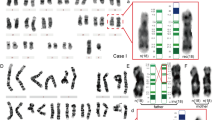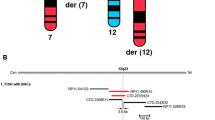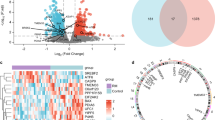Abstract
Translocations occur in a proportion of couples affected by recurrent miscarriages. We describe two such families in which the underlying cause was a cryptic subtelomeric 11p;17p translocation detected only after the birth of an affected child carrying an unbalanced form of the rearrangement. Unbalanced subtelomeric rearrangements are now recognised as a significant cause of mental impairment and we believe that these rearrangements may also be an important cause of recurrent miscarriages. In these two families the translocation is most likely to have arisen from a single ancestral event because all translocation carriers shared almost identical haplotypes around the breakpoints on both chromosomes.
Similar content being viewed by others
Log in or create a free account to read this content
Gain free access to this article, as well as selected content from this journal and more on nature.com
or
References
Campana M, Serra A, Neri G . Role of chromosome aberrations in recurrent abortion: a study of 269 balanced translocations Am J Med Genet 1986 24: 341–356
Bourrouillou G, Colombies P, Dastugue N . Chromosome studies in 2136 couples with spontaneous abortions Hum Genet 1986 74: 399–401
Castle D, Bernstein R . Cytogenetic analysis of 688 couples experiencing multiple spontaneous abortions Am J Med Genet 1988 29: 549–556
Flint J, Wilkie AO, Buckle VJ, Winter RM, Holland AJ, Mcdermid HE . The detection of subtelomeric chromosomal rearrangements in idiopathic mental retardation Nature Genet 1995 9: 132–140
Knight SJL, Regan R, Nicod A et al. Subtle chromosomal rearrangements in children with unexplained mental retardation Lancet 1999 354: 1676–1681
Knight SLJ, Lese CM, Precht KS et al. An optimised set of human telomeres clones for studying telomere integrity and architecture Am J Hum Genet 2000 67: 320–332
Reigel M, Baumer A, Jamar M et al. Submicroscopic terminal deletions and duplications in retarded patients with unclassified malformation syndromes Hum Genet 2001 109: 286–294
Rosenberg MJ, Killoran C, Dziadzio L et al. Scanning for telomeric deletions and duplications and uniparental disomy using genetic markers in 120 children with malformations Hum Genet 2001 109: 311–318
Rossi E, Piccini F, Zollino M et al. Cryptic telomeric rearrangements in subjects with mental retardation associated with dysmorphism and congenital malformations J Med Genet 2001 38: 417–420
Slavotinek A, Rosenberg M, Knight S et al. Screening for submicroscopic chromosome rearrangements in children with idiopathic mental retardation using microsatellite markers for the chromosome telomeres J Med Genet 1999 36: 405–411
Fan YS, Zhang Y, Speevak M, Farrell S, Jung JH, Siu VM . Detection of submicroscopic abberration in patients with unexplained mental retardation by fluorescence in situ hybridization Genet Med 2001 3: 416–421
Joyce CA, Dennis NR, Cooper S, Browne CE . Subtelomeric rearrangements: results from a study of selected and unselected probands with idiopathic mental retardation and control individuals by using high-resolution G-banding and FISH Hum Genet 2001 109: 440–451
Bacino CA, Kashork CD, Davino NA, Shaffer LG . Detection of a cryptic translocation in a family with mental retardation using FISH and telomere region-specific probes Am J Med Genet 2000 5: 250–255
Brackley KJ, Kilby MD, Morton J, Whittle MJ, Knight SJ, Flint J . A case of recurrent congenital fetal anomalies associated with a familial subtelomeric translocation Prenat Diagn 1999 19: 570–574
Giardino D, Finelli P, Gottardi G et al. Cryptic subtelomeric translocation t(2;16)(q37;q24) segregating in a family with unexplained stillbirths and a dysmorphic, slightly retarded child Eur J Hum Genet 2001 9: 881–886
Leppig KA, Ball S, Au K, Opheim KE, Norwood T . Familial cryptic (20;21) translocation identified by in situ hybridization technologies Am J Med Genet 2000 93: 273–277
Shaffer LG, Spikes AS, Macha M, Dunn R . Identification of a subtle chromosomal translocation in a family with recurrent miscarriages and a child with multiple congenital anomalies. A case report J Reprod Med 1996 41: 367–371
Wakui K, Tanemure M, Suzumori K et al. Clinical applications of two-color telomeric fluorescence in situ hybridization for prenatal diagnosis: identification of chromosomal translocation in five families with recurrent miscarriages or a child with multiple congenital anomalies J Human Genet 1999 44: 85–90
Yakut S, Berker-Karauzum S, Simsek M, Zorlu G, Trak B, Luleci G . Telomere-specific fluorescence in situ hybridization analysis of couples with five or more recurrent miscarriages Clin Genet 2002 61: 26–31
Overhauser J, Bengtsson U, McMahon J et al. Prenatal diagnosis and carrier detection of a cryptic translocation by using DNA markers from the short arm of chromosome 5 Am J Hum Genet 1989 45: 296–303
Altherr MR, Bengtsson U, Elder FFB et al. Molecular confirmation of Wolf-Hirschhorn syndrome with a subtle translocation of chromosome 4 Am J Hum Genet 1991 49: 1235–1242
Alvarado M, Bass HN, Caldwell S, Jamehdor M, Miller AA, Jacob P . Miller-Dieker syndrome. Detection of a cryptic chromosome translocation using in situ hybridization in a family with multiple affected offspring Am J Dis Child 1993 147: 1291–1294
Kohler A, Hain J, Muller U . Familial half-cryptic translocation t(9;17) J Med Genet 1994 31: 712–714
Kuwano A, Ledbetter SA, Dobyns WB, Emanual BS, Ledbetter DH . Detection of deletions and cryptic translocations in Miller-Dieker syndrome by in situ hybridisation Am J Hum Genet 1991 49: 707–714
Masuno M, Imaizumi K, Nakamura M, Matsui K, Goto A, Kuroki Y . Miller-Dieker syndrome due to maternal cryptic translocation t(10;17)(q26.3;p13.1) Am J Med Genet 1995 4: 441–443
van Zelderen-Bhola SL, Breslau-Siderius EJ, Beverstock GC et al. Prenatal and postnatal investigation of a case with Miller-Dieker syndrome due to a familial cryptic translocation t(17;20)(p13.3;q13.3) detected by fluorescence in situ hybridization Prenat Diagn 1997 17: 173–179
Weber LM, Garson OM . Fluorodeoxyuridine synchronization of bone marrow cultures Cancer Genet Cyogenet 1983 8: 123–132
Pinkel D, Straume T, Gray JW . Cytogenetic analysis using quantitative, high sensitivity, fluorescence hybridization Proc Natl Acad Sci USA 1986 83: 2934–2938
Pinkel D, Landegent J, Collins C et al. Fluorescence in situ hybridization with human chromosome specific libraries: detection of trisomy 21 and translocations of chromosome 4 Proc Natl Acad Sci USA 1988 85: 9138–9142
National Institutes of Health and Institute of Molecular Medicine Collaboration. A complete set of human telomeric probes and their clinical application Nature Genet 1996 14: 86–89
Miller SA, Dykes DD, Polesky HF . A simple salting out procedure for extracting DNA from human nucleated cells Nucleic Acids Res 1988 16: 1215
Broman KW, Weber JL . Long homozygous chromosomal segments in reference families from the Centre d'Etude du Polymorphisme Humain Am J Hum Genet 1999 65: 1493–1500
de Vries BBA, White SM, Knight SJL et al. Clinical studies on submicroscopic subtelomeric rearrangements: a checklist J Med Genet 2001 38: 145–150
Fan YS, Zhang Y . Subtelomeric translocations are not a frequent cause of recurrent miscarriages Am J Med Genet 2002 109: 154
Acknowledgements
We are indebted to the families of MW and LT, without whom this study could not have taken place. We thank Dr J Flint and Dr L Kearney for kindly donating the panel of subtelomere clones used in this study and Will Tapper for his expert database analysis. We are particularly grateful to Prof PA Jacobs and Dr JA Crolla for their advice and encouragement. We also wish to thank Mary Hart and Rebecca Protheroe for maintaining the library of FISH probes.
Author information
Authors and Affiliations
Corresponding author
Rights and permissions
About this article
Cite this article
Joyce, C., Dennis, N., Howard, F. et al. An 11p;17p telomeric translocation in two families associated with recurrent miscarriages andMiller-Dieker syndrome. Eur J Hum Genet 10, 707–714 (2002). https://doi.org/10.1038/sj.ejhg.5200882
Received:
Revised:
Accepted:
Published:
Issue date:
DOI: https://doi.org/10.1038/sj.ejhg.5200882



